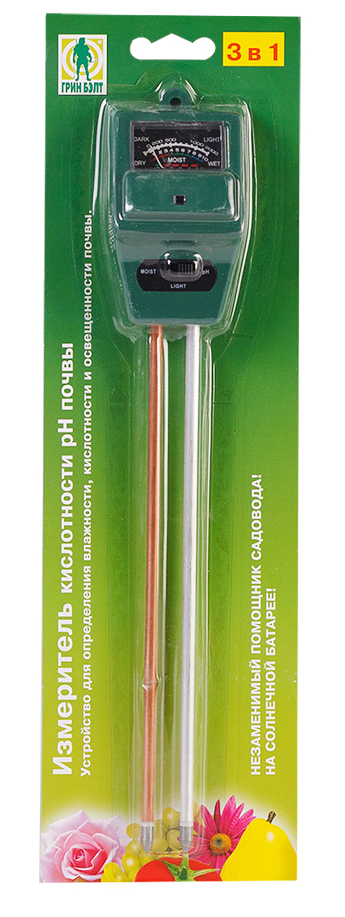Rating of the best soil acidity meters (PH meters) for 2022
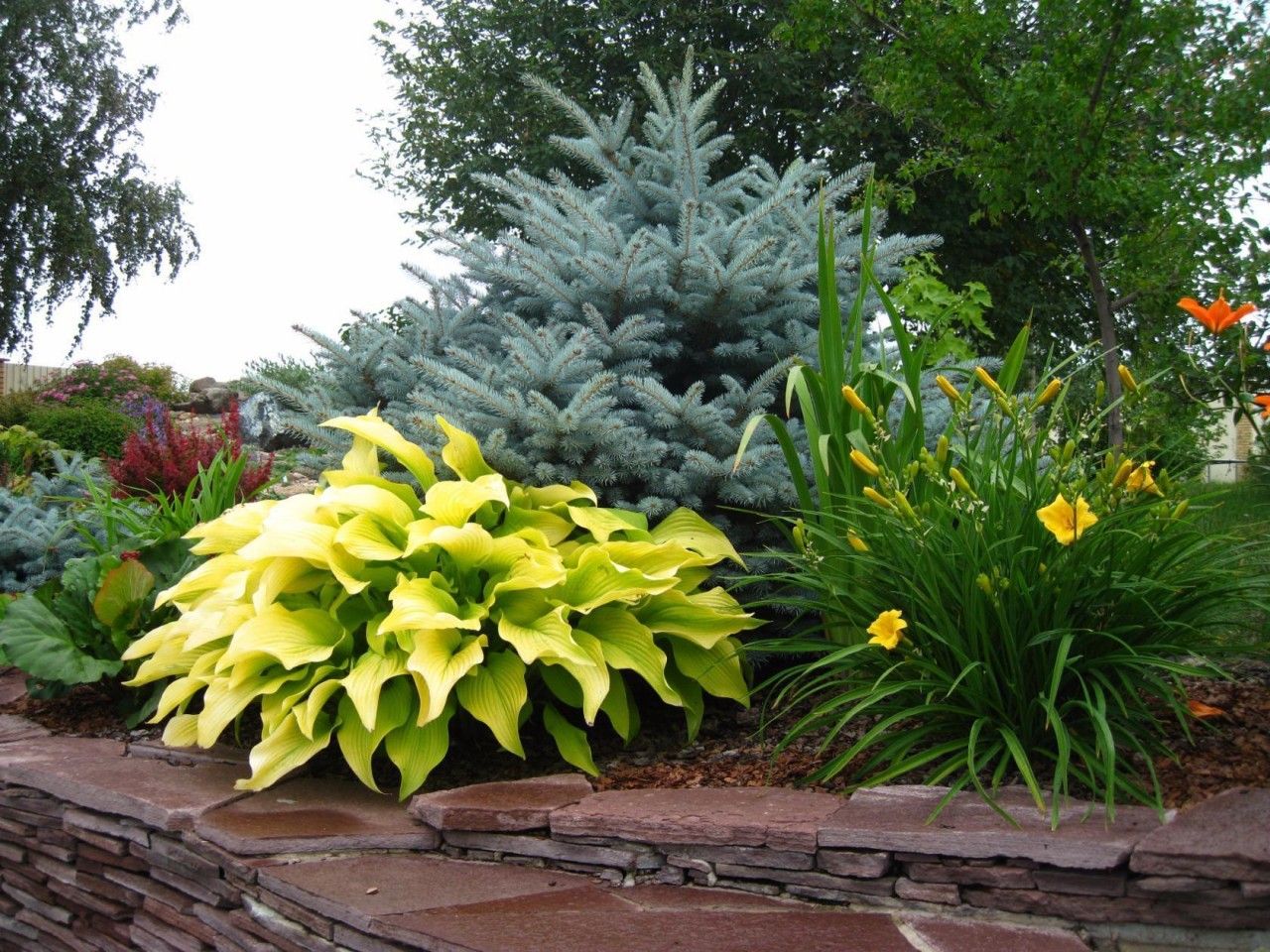
According to numerous observations of gardeners-gardeners over the process of growth and development of various crops, it was concluded that the same plants do not feel equally comfortable on different types of soil. One of the most significant reasons for this is the level of acidity of the substrate. Therefore, it is so important to have a soil acidity meter or pH meter handy.
Content [Hide]
- 1 Soil acidity scale
- 2 What is the need for measurement?
- 3 Rating of the best electronic pH meters for measuring soil acidity for 2022
- 3.1 ATM - 300 - made in China
- 3.2 Multimonitor Luster Leaf Rapitest 1880 - made in China
- 3.3 Luster Leaf Rapitest 1835 - made in China
- 3.4 Soil pH meter 3 in 1 - made in China
- 3.5 Green Belt 3 in 1 06-091 - made in Russia
- 3.6 Luster Leaf Rapitest 1847 - made in China
- 3.7 Luster Leaf Rapitest 1845 - made in China
- 3.8 ETP-330 - Made in China
- 3.9 BIOGROD company Klioma Service - made in China
- 3.10 Luster Leaf Rapitest 1817 - Made in China
- 3.11 Luster Leaf Rapitest 1810 - Made in China
- 4 Litmus paper
Soil acidity scale
Since acidity is the presence of hydrogen ions in the structure of the earth, more or less of them determines its level. It is designated pH and has its own scale. A reading of 7.0 is in the middle of the scale and means the soil is neutral. The values located to the left of this figure indicate that the acidity of the earth increases with decreasing numbers on the scale. Conversely, with their increase, the degree of acidification becomes alkaline.
Optimum acidity level for horticultural crops
All vegetable plants, fruit bushes and trees are very sensitive to acidic soil, and many of them are not able to develop and bear fruit well in such an environment. Therefore, before planting, it is recommended by experienced specialists to check the degree of soil acidity and, if necessary, reduce it by neutralization.
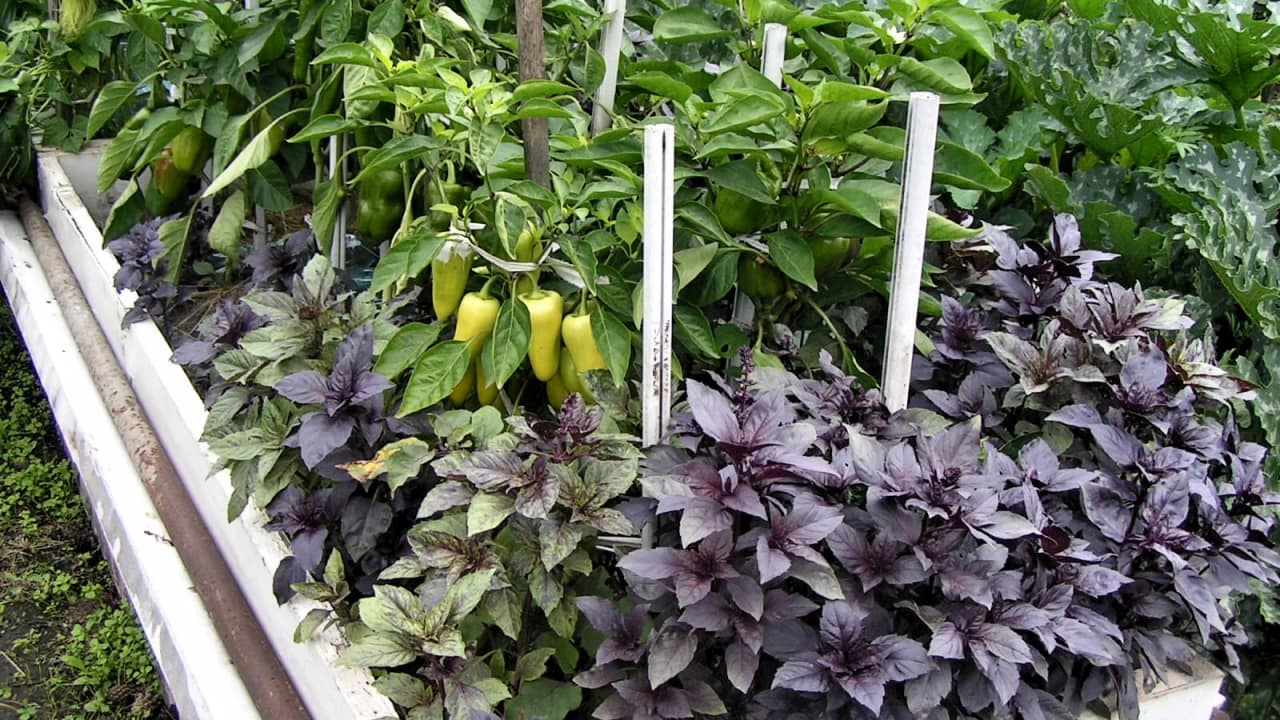
So, for example, below is a table with an acceptable pH level for vegetable crops:
| culture | Optimal pH |
| Watermelon, strawberry, rhubarb, potato, chicory | 5,5- 6,4 |
| Tomatoes, peas, cucumbers, corn, carrots, beans | 5,8-6,4 |
| Asparagus | 6.2 |
| Cabbage, broccoli, beets | 6,2-6,6 |
What is the need for measurement?
One of the main reasons why it becomes necessary to check the degree of soil acidity is to obtain the maximum and high-quality yield. To achieve this, it is necessary to provide the most comfortable and favorable conditions for the grown plants. For the nutrition of crops, substances that are in the earth in an appropriate state are necessary. The same structure should be fertilizers applied to the soil. But in the presence of high acidity, such a result is very difficult to achieve. As a result, the plants will get sick, develop poorly and will not give the expected harvest.
Therefore, experienced agronomists very carefully prepare the soil before sowing, introducing certain necessary funds to neutralize or alkalize it.
Methods for determining the value of acidity
There are several ways to find out the degree of acidification of the soil. This can be determined visually, chemically or by measuring with special devices.
The first method is very general, as it is determined by the plants growing in the area being measured.
- If sorrel, blueberries, horsetail, oxalis and moss grow wildly on it, then we can safely say that the ground under them has a pH level of 5.3 to 6.0. This is acidic land.
- Shepherd's purse, common chicory, wheatgrass, feather grass, creeping clover, carnation, sow thistle, bluebells, which feel comfortable on the checked area, indicate a neutral degree of acidity. Its values are in the range from 6.0 to 7.2.
- The presence of pines, sowing chestnuts, as well as thickets of field bindweed, alfalfa, coltsfoot, thyme, sedge, May lily of the valley or lady's slipper indicates the alkaline structure of the soil. Its value is from 7.3 to 8.1.
The second method is more laborious and not entirely accurate. It only allows you to recognize whether the soil in the area is acidic, neutral or alkaline. To do this, it is necessary to carry out certain experiments with the soil, adding vinegar, soda or other components to it. According to the obtained chemical reactions or their absence, it is possible to determine the quality of the earth. But it is rather problematic to achieve a digital value from such an option. But even a tenth of the value can have a significant impact on the crop being grown.
Also, the chemical method for measuring the degree of soil pH includes determining the color of a strip of litmus paper on a scale. By contacting it with well-moistened soil, it changes color depending on the condition of the soil. After comparing it with the gradation presented on the package, you can find out how acidic, neutral or alkaline it is.
The third option is very convenient, accurate and practical. By immersing the electrodes of the device into the ground, it is possible to determine the pH level or its absence with great accuracy.
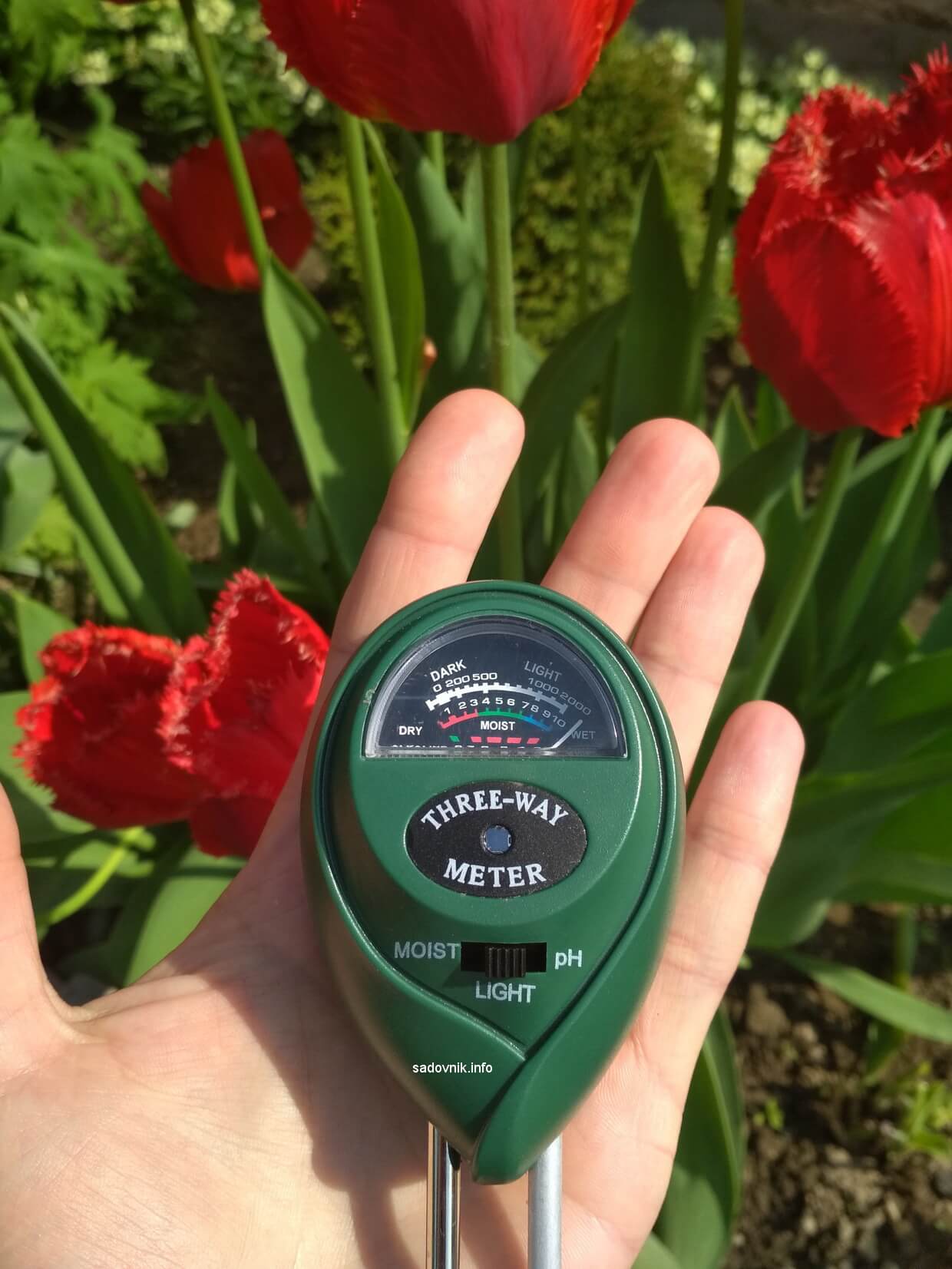
The main country that develops such meters is currently America. Manufacturers of Western firms have been producing only highly specialized pH meters for several years, but recently they have switched to creating more universal models that allow measuring not only the level of soil acidification, but also moisture content, the amount of nitrates.
Rating of the best electronic pH meters for measuring soil acidity for 2022
Without a doubt, the first positions of many rankings of the best soil pH meters for 2022 are universal ones that include several functions.
ATM - 300 - made in China
votes 191
A universal meter that includes the functions of 4 features:
- acidity;
- light flux;
- humidity level;
- temperature regime.
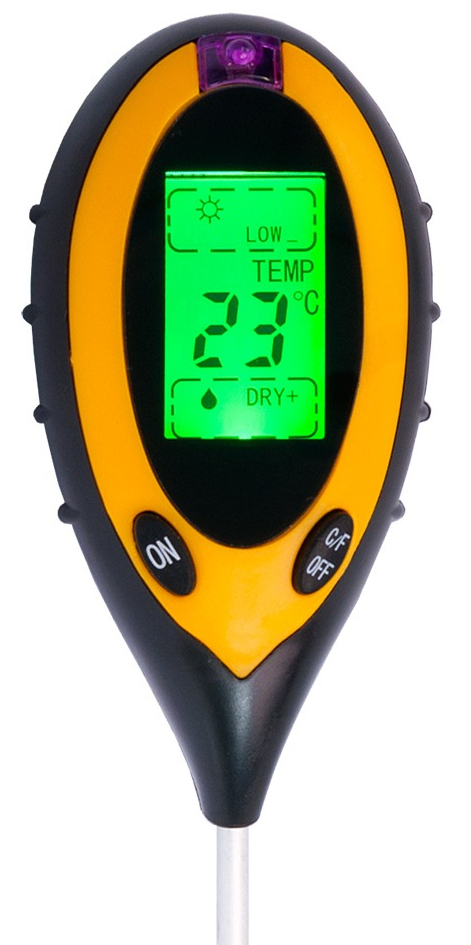
Characteristics:
| Luminous flux measurement | 9 steps |
| Determination of the degree of acidification | 12 levels |
| Humidity level | 5 values |
| Temperature range | -9°C to +50°C (16°F to 122°F) |
| Batteries | by 9 V |
| Options | 12.2 x 6.3 x 3.6 cm |
| Electrode dimensions | length - 20 cm, diameter - 0.5 cm |
| Weight without batteries | 70.5 gr. |
The kit includes:
- tester;
- instructions for use in English and Russian;
- package.
Mode of application:
- To use the meter, it must be held by the electrode body.
- Lower into the ground to such a depth as to ensure tight contact with it.
- Leave for 30-60 seconds. to complete the results on the screen. Remove the electrode from the soil, press the "OF" button and clean it.
- Versatility;
- Ease of use;
- The device is equipped with an automatic shut-off function that works after 5 minutes. after the end of the measurement.
- In order to derive accurate average values, it is recommended to take several measurements in one area.
Multimonitor Luster Leaf Rapitest 1880 - made in China
votes 64
This device is equipped with 4 functions and determines:
- degree of pH;
- stream of light;
- soil fertility;
- moisture contents.
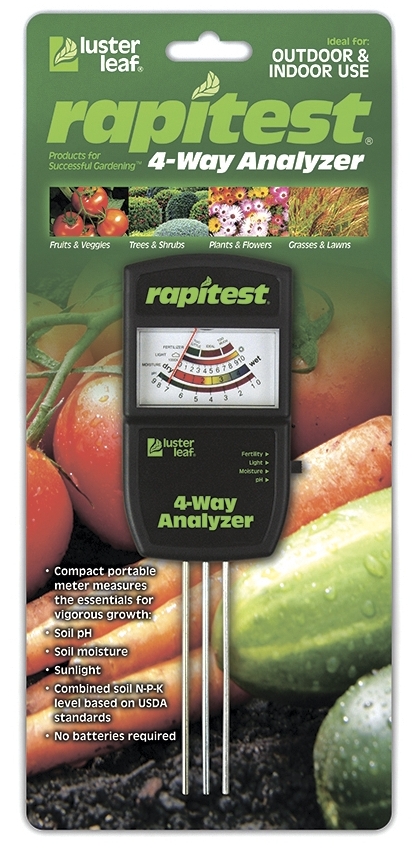
Characteristics:
| pH measuring range | 3,5-8,0 |
| Measuring span of the luminous flux | 0-2000 lux |
| Moisture measurement interval | 1-10 (10% - 100% RH) |
| Options | 26 x 6 x 3.8 cm |
| Rod length | 19 cm |
| Weight | 122 gr. |
| Design and development | USA |
- A feature of this meter is that it shows the fertility of the soil in a combination of potassium, phosphorus and nitrogen necessary for the life of garden and horticultural crops. In the absence of any of these components in the ground, the multimonitor will immediately notify you about it.
- The Luster Leaf Rapitest 1880 multi-monitor does not require batteries to operate.
- This device is applicable only when taking measurements of the soil. It is forbidden to use the tester in water and its solutions.
Luster Leaf Rapitest 1835 - made in China
votes 69
The adaptation of this group is necessary to determine:
- the degree of acidification of the earth;
- temperature regime;
- fertility level.
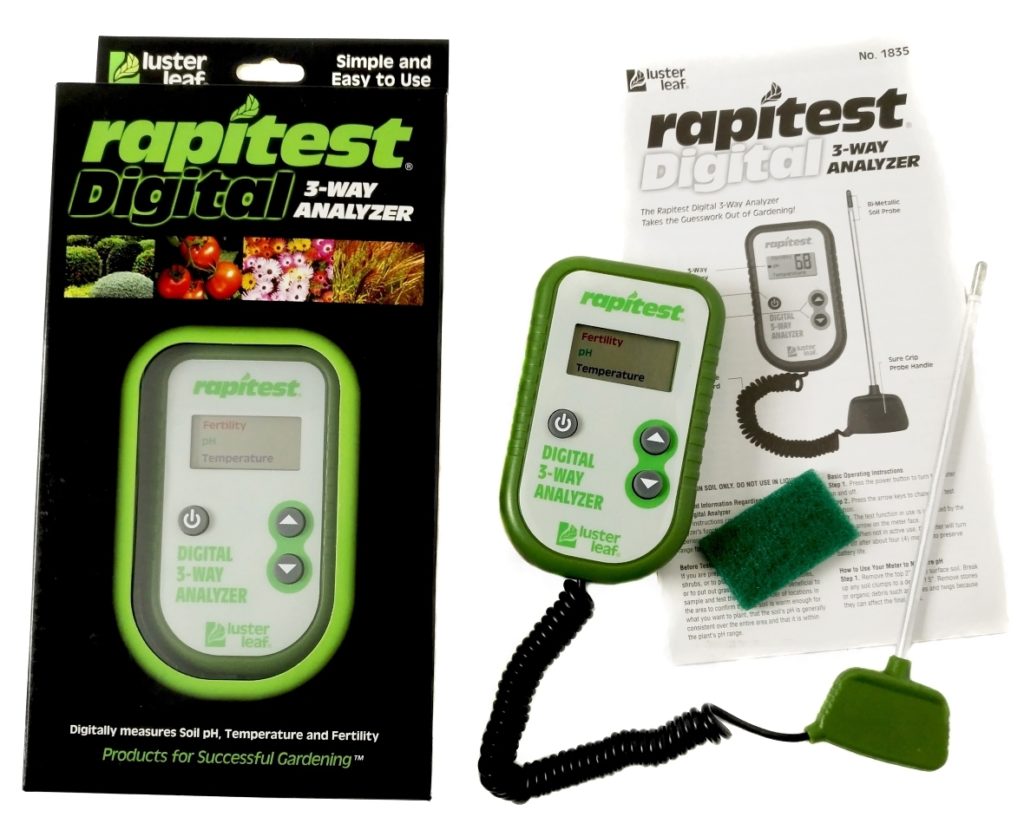
Characteristics:
| Options | 15.2 x 3.6 x 4.6 cm |
| Case dimensions | 10.8 x 6.4 cm |
| Electrode length | 16.5 cm |
| The weight | 136 gr. |
| Wire length | 8 cm |
| Design and development | USA |
Equipped with LR44 power supply and 3 batteries, the charge of which is enough for 1000-1200 measurements.
- ease of reading the measurement indicators on the display;
- guarantee of accurate results.
The Luster Leaf Rapitest 1835 tester was recognized in 2013 as a favorite among such inventions. An independent jury, as well as experienced gardeners, singled it out from the rest thanks to the innovation of technology, exclusivity and the ability to perfectly solve the problems of gardening and horticulture.
- There are no significant ones.
Soil pH meter 3 in 1 - made in China
votes 60
This instrument measures:
- degree of soil acidity;
- humidity level;
- soil illumination.
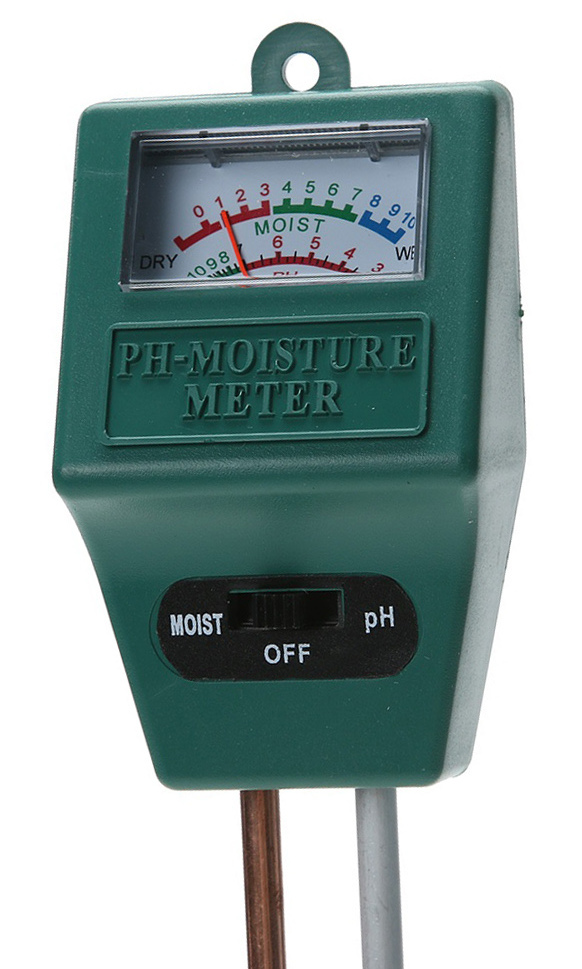
Characteristics:
| Measuring range of pH level | 3,5-8,0 |
| Moisture detection interval | 0-10 |
| Luminous flux scale | 0-2000 lux |
| Options | 26 x 6 x 3.7 |
| Rod length | 20 cm |
| The weight | 65 gr. |
| Possible deviations in the readings: | |
| pH | 0.5 |
| illumination | 50.0 lux |
| humidity | 0.1 |
The kit includes:
- device;
- additional electrode;
- warranty card;
- package.
Mode of application:
This measuring tool is very easy to use and does not require special knowledge and skills. It can be used by both professionals and beginners.
So, to measure the degree of illumination of the soil, it is enough:
- put the lever in the appropriate position;
- insert the electrode into the soil to the required depth;
- turn the screen of the built-in solar battery to the light source.
In this case, nothing should prevent the light from reaching the tester.
To measure soil pH:
- set the switch to the corresponding function;
- clean the electrode rod with a piece of fine-grained sandpaper for polishing, and then wipe it with a napkin;
- prepare a certain amount of soil by removing foreign objects and debris from it (stones, glass, plastic, weeds);
- moisten the earth;
- immerse the electrode into it to the beginning of the body and wait 5 minutes;
- to fix the received value on the screen.
When measuring soil moisture, you must:
- set the desired mode;
- clean the probe of the device from the remnants of previous use;
- lower the tip into the ground;
- take a screen shot.
Depending on the displayed values, soil moisture is divided into 3 types:
- from 1 to 3 (red area) - the ground is dry or slightly wet;
- 3 to 8 (green area) - slightly wet or quite wet;
- from 8 to 10 (blue area) - too wet soil.
- Multifunctionality;
- Easy to use.
- There are no significant ones.
Green Belt 3 in 1 06-091 - made in Russia
votes 105
This measuring device performs 3 functions:
- the strength of the light flux;
- pH level;
- the presence of moisture in the soil.
Exploitation:
Before each use, be sure to clean the rods of the device.
Having set the switch to the required function, immerse the electrodes into the ground until they are in full contact with it. After waiting a certain period of time, fix the result shown and compare it with the scale presented in the instructions.
When recharging the meter, its screen should be turned to a source of sunlight and left to the maximum battery level.
- versatility and ease of use;
- profitability;
- recharging only from the solar battery.
- No significant ones noted.
Luster Leaf Rapitest 1847 - made in China
votes 4
The advantage of this pH meter is the programmed base of the required degree of acidity for 4 hundreds of fruits, vegetables and ornamental plants. This feature also allows instrument owners to create their own crop list and store it in the analyzer's memory.
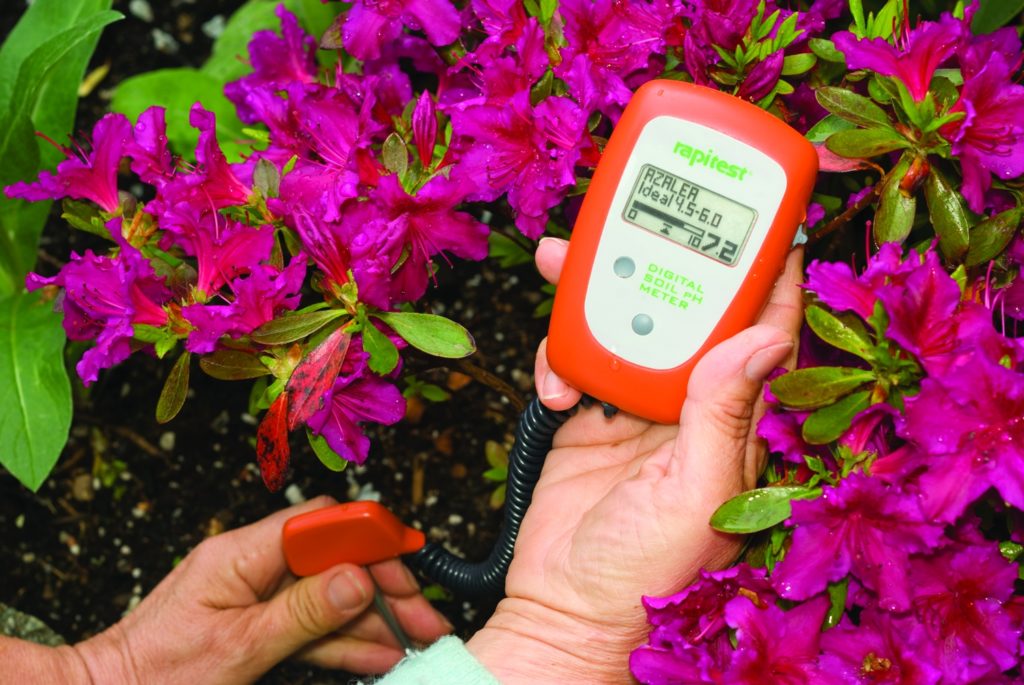
Characteristics:
| Instrument parameters | 19.5 x 6.5 x 3.0 cm |
| Case dimensions | 10 x 6 x 3 cm |
| Rod length | 16.5 cm |
| Wire size | 8 cm |
| Weight | 150 gr. |
| Acidity measurement interval | 3.5 - 9.0 pH |
| Design and development | USA |
Method of application: Equipped with a power supply and 3 batteries, designed for 1000-1200 measurement procedures.
In order to start measuring, you should select the necessary plant or crop from the list provided on the screen, next to which the optimal soil pH level is indicated, and then carry out the measurement process. The result will be highlighted next to the already existing value. By comparing the values, decide on a pH adjustment.
- Having your own database with values;
- Possibility of supplementing the basics with plants grown in a particular area.
- No.
Luster Leaf Rapitest 1845 - made in China
votes 20
The digital tester has 1 function - soil pH measurement.
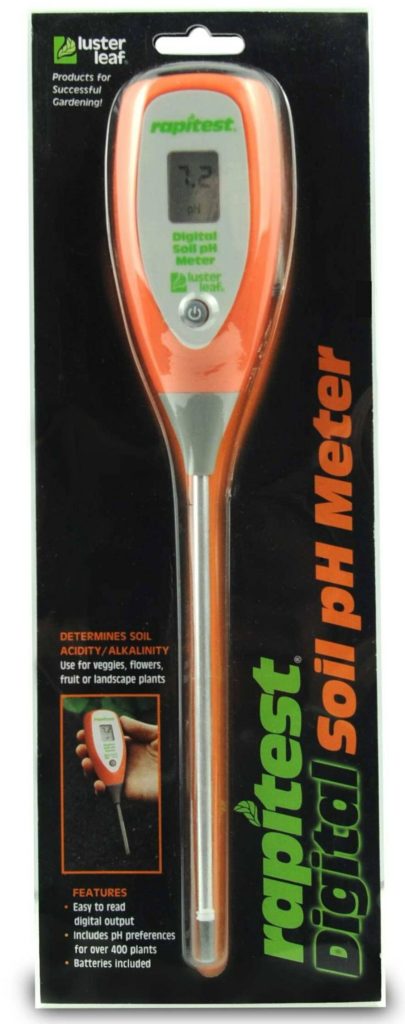
Characteristics:
| Machine Settings | 26 x 2.5 x 4.5 cm |
| Case size | 11 x 4 x 2.5 cm |
| Electrode length | 14.5 cm |
| Weight | 85 gr. |
| measuring range | 3.5 - 9.0 pH |
| Interval between divisions | 0.1 pH |
The device is completed with the power supply unit and 3 batteries. Their charge is enough for 1000-1200 measurements. In addition to the instructions, a booklet is attached with information on the recommended degree of soil acidity for 400 plants.
- comfortable in using;
- the values on the display are easy to see.
- Monofunctional.
ETP-330 - Made in China
votes 28
The representative of this brand performs only one function - measuring the degree of soil acidification.
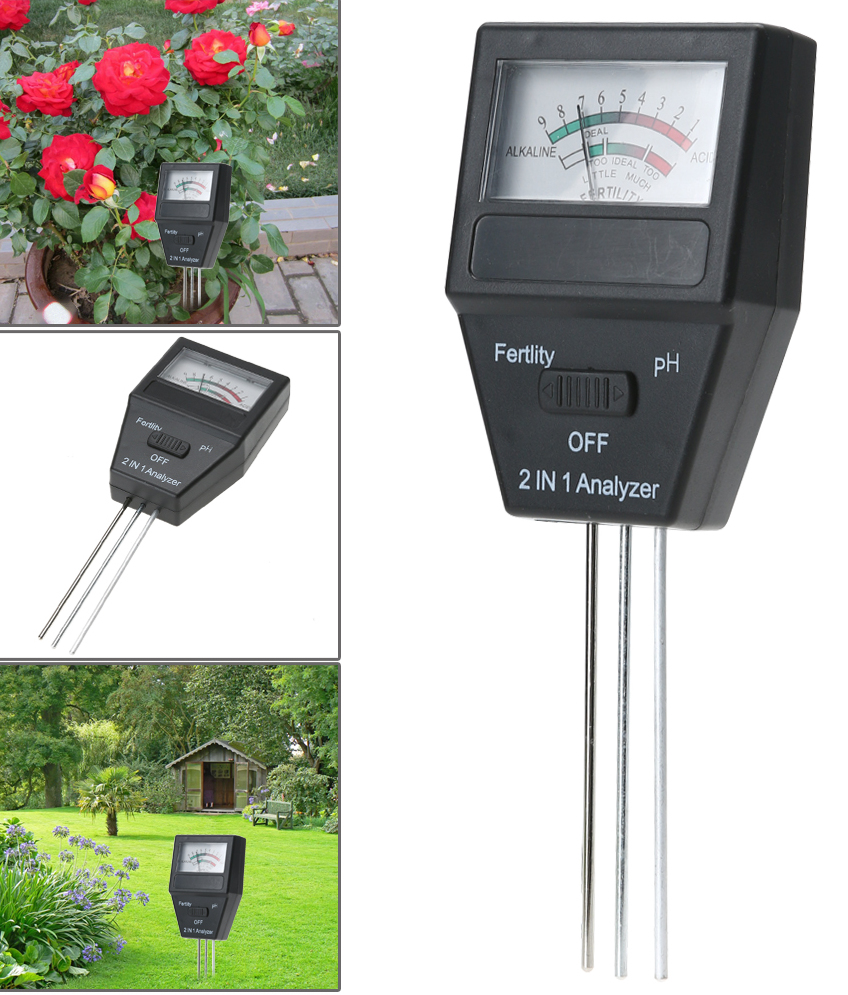
Characteristics:
| Dimension span | 3-10 |
| Possible deviation of the result | 0.5 pH |
| Electrode rod length | 20 cm |
| Design and development | USA |
Included:
- device with 1 electrode,
- Russian-language instruction,
- package.
Working rules:
- lower the probe rod into the ground until it makes good contact with it;
- after 40-60 sec. fix the position of the arrow on the screen;
- determine the acid, neutral or alkaline level of the soil by the color of the indicator.
- Ease of use;
- Understandability of the received values.
- Only one function.
BIOGROD company Klioma Service - made in China
votes 33
The device is equipped with one function.
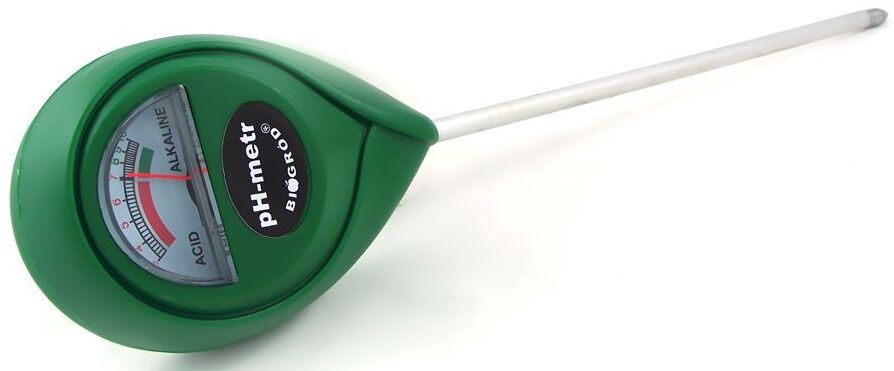
Characteristics:
| Type of | Portable, portable |
| measuring range | 2.0 - 7.0 pH |
| Possible deviations +/- | 0.1 pH |
Mode of application:
- If necessary, clean the electrode tip.
- Remove foreign objects and debris from the soil.
- Moisten the soil.
- Insert the rod vertically to the required depth.
- After holding for 20-30 seconds, fix the readings of the device.
- ease of use;
- accuracy of indications;
- profitability;
- no need for power supply.
- Only one function.
Luster Leaf Rapitest 1817 - Made in China
votes 10
A very comfortable, simple and miniature analyzer of the pH level and moisture in the ground is quite popular among gardeners and lovers of indoor flowers. It allows you to effectively measure close to the roots of crops, without causing them any tangible harm.
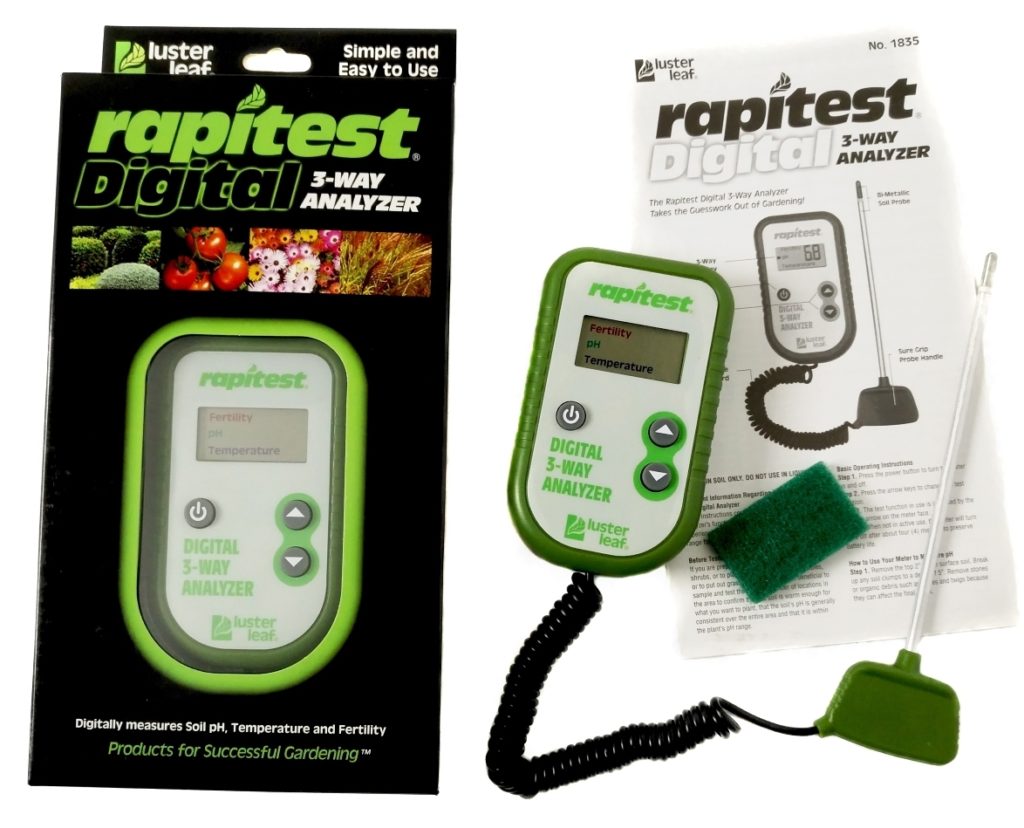
Characteristics:
| Measuring range of earth acidification | 4-8 pH |
| Humidity interval | A-B-C-D |
| Design and development | USA |
Usage method:
Immerse the electrode vertically into the prepared soil for 2/3 of the length. The distance to the stem of the plant should be at least ½ of the radius of the pot. After a few seconds, two indicators can be seen on the display - the pH level and soil moisture.
- This analyzer does not need additional electrical power and batteries, as it is charged using a solar battery;
- It includes a booklet with a list of the optimal degree of acidity for 50 crops and humidity for 100 plant species.
- There are no significant ones.
Luster Leaf Rapitest 1810 - Made in China
votes 8
This miniature soil acidification analyzer is very convenient to use. With it, you can take pH measurements, both in pots of indoor flowers, in flower beds and in personal plots.
Measurements of values should be carried out similarly to other instruments, but, according to the recommendations of experts, it is advisable to do this procedure at some distance from the plant, and not at the root system itself.
Important! This instrument is not suitable for use in the measurement of water and solutions.
To extend the life of the pH meter, after each measurement process, it must be rinsed with water and wiped with a napkin.
- the stem is made of stainless steel;
- does not need electrical power;
- in addition to the instructions, it comes with a guide to the required pH level for 50 plants.
- Only for soil, it is impossible to measure indicators in liquids.
Litmus paper
Measuring the acidity of the earth using strips of litmus paper is the easiest and most budgetary option. A set of strips with a color scale can be purchased at some pharmacies or online stores.

Mode of application:
To carry out the procedure for determining the pH of the soil, it is necessary to take a high-quality sample. It is recommended to use the earth from a depression 20-25 cm long. Place it in a deep bowl and add some distilled water. Mix thoroughly and leave for 15 minutes. Then stir well again.After that, attach a strip of litmus paper to the ground and wait a few minutes. According to the obtained color, which the litmus has acquired, it is possible to determine the degree of acidity of the soil by comparing it with the scale presented on the package.
The value of the indicator by color
- A bright red color or its shades indicate a high or increased acidity of the soil.
- The green color and the shades closest to it speak of its neutrality.
- Yellow and pale yellow represent the alkaline degree.
For a general determination of acid in the soil, litmus paper with a large step of the color scale can be used. To find out a more accurate value of the result, it is advisable to use litmus strips with a fine scale step.
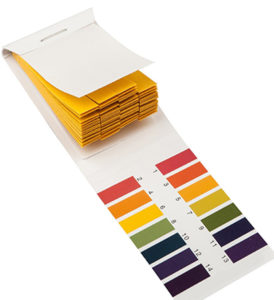
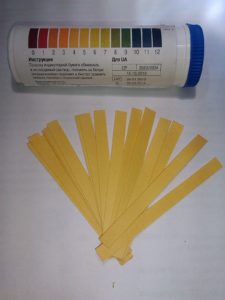
Of course, with so many possible options for choosing pH meters, there is no need to rush when buying, but it is advisable to carefully consider and determine your occupation, the required range of functions of the device. Having chosen the most convenient, high-quality universal or specialized meter, compare prices and give preference to the most optimal option.
We hope that the selection of characteristics and preferences of users of devices of this category, presented in the article, will become an indispensable assistant to everyone in their choice.
new entries
Categories
Useful
Popular Articles
-

Top ranking of the best and cheapest scooters up to 50cc in 2022
Views: 131650 -

Rating of the best soundproofing materials for an apartment in 2022
Views: 127689 -

Rating of cheap analogues of expensive medicines for flu and colds for 2022
Views: 124518 -

The best men's sneakers in 2022
Views: 124032 -

The Best Complex Vitamins in 2022
Views: 121939 -

Top ranking of the best smartwatches 2022 - price-quality ratio
Views: 114979 -

The best paint for gray hair - top rating 2022
Views: 113394 -

Ranking of the best wood paints for interior work in 2022
Views: 110318 -

Rating of the best spinning reels in 2022
Views: 105328 -

Ranking of the best sex dolls for men for 2022
Views: 104365 -

Ranking of the best action cameras from China in 2022
Views: 102215 -

The most effective calcium preparations for adults and children in 2022
Views: 102011
